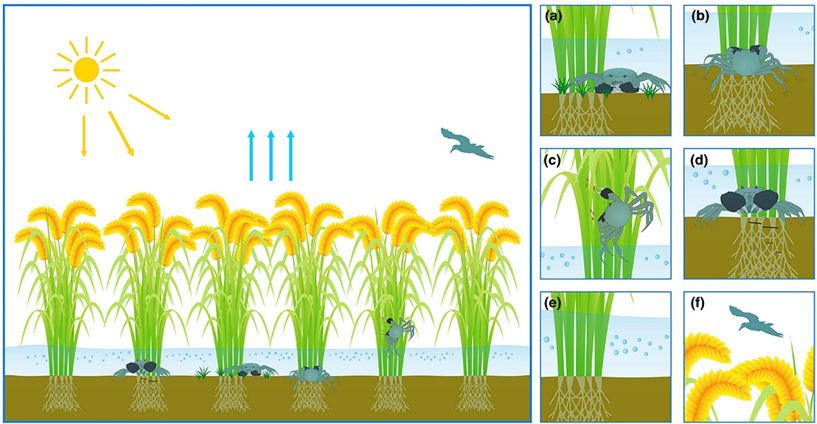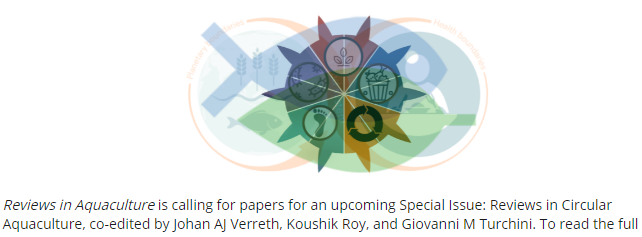

Figure Symbiotic system of rice and crab
A. River crabs feed on weeds; B. River crabs loosen soil; C. River crabs prey on pests; D. River crab excrement provides fertilizer; E. Rice purifies water; F. Rice protects river crabs from natural enemies
Summary
Rice field culture of Chinese mitten crab Eriocheir sinensis (river crab) is the most representative model of comprehensive breeding developed in China in the past three decades. Compared with rice monocropping, the economic and ecological benefits of rice-crab co-cropping are significantly improved. Under co-cultivation conditions, rice provides refuge for river crabs, improving the water environment, while river crabs eliminate pests and weeds, reduce the need for fertilizers and pesticides, and stabilize rice yields. At the same time, rice-crab co-culture helps protect biodiversity and reduce greenhouse gas emissions. Through in-depth research, my country's rice-crab co-culture technology has made great progress, and an ecological breeding model with regional characteristics has been established. These studies have formed relatively complete breeding industry standards in terms of paddy field engineering, seedling stocking, water quality control, feed feeding, pest control, and breeding management. However, more research is needed to standardize rice field engineering, optimize co-cultivation models, elucidate nutrient requirements of river crabs, develop disease prevention and control methods, elucidate the operating mechanism of rice-crab co-culture, and determine energy-substance exchanges with the external environment. Ultimately, rice-crab co-culture can be highly integrated to utilize minimal resources while providing maximal economic and environmental benefits. This paper reviews the development history, economic benefits, organisms in the system (rice, river crabs, plankton, benthic animals, weeds and microorganisms), internal and external environmental benefits, and future development directions of rice crab integrated breeding and breeding. Provide theoretical reference for further research in the field of nutrition.
Key words
Economic benefits, environmental benefits, river crabs, mutual benefit and symbiosis, comprehensive cultivation of rice crabs
Abstract
Chinese mitten crab (Eriocheir sinensis) culture in rice paddy fields is a representative model of integrated agriculture-aquaculture systems developed in China over the last 30 years. The economic and ecological benefits of rice-crab coculture are significantly improved compared to those of rice monoculture. Under coculture conditions, rice provides shelter for crabs and improves the aquatic environment, while crabs eliminate pests and weeds, reduce the need for chemical fertilizers and pesticides, and stabilize rice production. At the same time, rice-crab coculture helps protect biodiversity and reduce greenhouse gas emissions. An in-depth study has led to the significant development of rice-crab coculture technology in China and has established ecological breeding models with regional characteristics. These studies have established breeding industry standards for paddy field engineering, stocking mode, water quality control, rice management, feeding, pest control and breeding management. However, more research is needed to standardize rice field engineering specifications, optimize coculture modes, clarify crab nutritional needs, develop disease prevention and control methods, elucidate the operational mechanism of rice crab coculture and ascertain energy-material exchange with the external environment. Eventually, rice-crab coculture can be highly integrated to utilize the fewest resources while providing the greatest economic and environmental benefits. This review provides a theoretical reference for further research in the field of rice-crab coculture, examining aspects such as development history, economic benefits, organisms in the system (rice, crabs, plankton, zoobenthos, weeds and microorganisms), internal and external environmental benefits, and the direction of future development.
keywords
economic benefits, environmental benefits, Eriocheir sinensis, mutualistic symbiosis, rice-crab coculture
Author's Comments
Rice is one of the most important crops in the world to feed a rapidly growing population and an important component of global food security. For decades, the main measures to improve rice production have included good irrigation methods, mechanized farming, and the use of chemical fertilizers and pesticides. The increase in rice production also brings many problems. For example, the excessive use of chemical fertilizers is generally serious, which leads to soil compaction, acidification, and degradation of cultivated land. At the same time, nitrogen and phosphorus discharges lead to eutrophication of water bodies. A large number of chemical pesticides are used in rice production. Although it has effectively prevented rice pests and weeds, it has also killed natural enemies of pests and other beneficial organisms in rice fields, resulting in a decline in biodiversity and serious damage to the ecological balance of the rice field ecosystem. Therefore, under the new form, rice production must shift from focusing on yield to improving quality and efficiency.
Integrated Agricultural Aquaculture Systems (IAAS) are based on the integration of aquaculture and agricultural systems and have been shown to be effective in promoting sustainable agricultural development and ensuring food security. In IAAS, the shallow water environment of paddy fields can provide habitat for aquatic organisms. Therefore, the practice of using paddy fields to breed aquatic animals has been carried out in the distribution areas of paddy fields around the world, forming a unique planting and breeding system for species diversity in paddy fields. In China, rice field farming of Chinese mitten crab Eriocheir sinensis (commonly known as river crab) is the most representative model of comprehensive farming developed in the past three decades. Rice fields provide suitable water environment and bait organisms for the survival of river crabs, which reduces the feed input required for crab breeding in rice fields to a certain extent. Nutrients excreted by river crabs can be absorbed and utilized by rice. In addition, river crabs disturb paddy soil, increase its porosity, and promote rice root growth and nitrogen uptake in soil. Therefore, the integrated cultivation of rice and crab improves resource utilization, reduces system nutrient loss, and improves rice yield and comprehensive benefits.
With the in-depth research on the comprehensive cultivation and breeding technology of rice and crab in China, ecological models with regional characteristics have gradually formed, such as: "Liaoning Panshan Model", "Ningxia Rice Crab Co-cultivation Model" and "Jilin Rice Field Crab Culture Technology" mode" etc. However, in order to obtain more economic value of the early rice-crab co-cropping technology, the main researches focus on the stocking density, stocking size, rice yield, and overall economic benefits of river crabs. With the development of scientific planting and breeding, the research on the ecological environment of paddy fields and the prevention and control of pests and diseases has gradually deepened. In particular, the harmonious development of economic, social and ecological benefits has received widespread attention. In this paper, the effects of rice-crab co-cropping on rice, river crabs, planktonic and benthic organisms, diseases, pests and weeds, soil, economic benefits, and environmental benefits were reviewed respectively.
Although encouraging results have been obtained, there are still many aspects that need to be further studied to further improve the rice-crab co-cultivation system and prove its mechanism as a typical symbiotic symbiotic farmland animal and plant integrated planting system. The first is the lack of improved varieties of crabs and rice that are suitable for paddy fields; in China, there are already 5 new varieties of river crabs in the country, but no new species breeding has been carried out for the paddy field environment. Small and not high quality. Similarly, crab farming requires that the rice planted has strong resistance to insect pests and lodging, and there is currently no specially selected rice variety. Therefore, it is very necessary and urgent to strengthen the selection of crab and rice varieties for comprehensive cultivation of rice and crab. The combination of good varieties is not only in line with the development trend of agriculture in the new era, but also can further improve the economic benefits of farmers; secondly, there is a lack of countermeasures for the occurrence of diseases; the current breeding adopts the strategy of not using drugs after stocking crabs, but the response measures for the occurrence of diseases are not yet available. Perfect, there is a lack of rice fertilization technology and rice disease, pest and weed prevention and control technology that is safe for crab breeding, and there are insufficient safe, ecological and environmentally friendly pesticide substitutes. For more than 30 years of breeding, the diseases of rice field river crabs are relatively rare, but the recent occurrence of river crab milk disease and other problems has brought a great impact on the industry and has a tendency to further deteriorate. At present, there is no effective method to prevent and control it. Research on disease control and rational drug use of Chinese crab is also urgently needed by the industry. Third, the breeding model still needs to be further optimized. In northern China, after the ice melts at the end of March, river crabs finish overwintering and start to eat feed, but rice transplanting is from the end of May to the beginning of June, and the temporary cultivation time of more than two months is due to the water grass If it is lacking, the survival rate of river crabs is low and the growth is slow. Therefore, it is still necessary to continuously explore how to do the temporary rearing work before stocking and the precise connection with the rice fields. In addition, the breeding of river crabs in paddy fields has achieved weight loss and drug reduction, but how to rationally fertilize and feed to achieve the best comprehensive benefits still needs further research. It is necessary to use isotope labeling and other technologies to clarify how the nutrients in the feed and fertilizer are. The flow between the rice and the crab and the role in the formation of the yield of the rice and the crab make it highly integrated between the rice and the crab, and achieve the purpose of saving the most resources, the best economic benefit, and the most obvious environmental benefit. Fourth, there is still a big gap in basic theoretical research. The ecological rice-crab breeding model realizes the organic combination of three-dimensional ecological breeding of rice in fields and crabs in water. It is a veritable resource-saving, environment-friendly and food-safe type. industry, but the basic theoretical research is far from keeping up with the development of the industry. For the inside of the system, the mutual beneficial symbiosis mechanism between rice and river crabs still needs to be clarified, what kind of protective effect does rice have on river crabs, how river crabs can efficiently adapt to the paddy field environment, the control mechanism of river crabs and natural enemies of pests on diseases, insects and weeds, and long-term breeding The impact of river crabs on the biodiversity of the system has not yet been resolved; for the entire system, the method and extent of energy and material exchange between the system and the external environment are still unclear, and these basic theoretical issues still require continuous research by researchers. Further guidance on aquaculture production.
In China, the development of the comprehensive rice and crab breeding industry is entering a new stage. This stage will focus on the pursuit of stable development of both grain output and farmers' income and efficiency, and will focus on producers, consumers and marketing. The industrial goal of business and tripartite win-win, truly scientifically realize "rice + river crab = food security + food security + ecological security + farmers' income increase + enterprise efficiency increase", and scientifically and rationally achieve the huge effect of '1+1=5'.
About the Author
Professor Li Xiaodong

Shenyang Agricultural University professor, doctor, doctoral supervisor, and chairman of Panjin Photosynthetic Crab Industry Co., Ltd. He has been engaged in aquatic animal breeding, seedling and healthy breeding technology research for a long time. He pioneered the "rice field crab breeding" model in northern my country and obtained an invention patent. In the past 30 years, the promotion of the results has promoted the development of the crab breeding industry and the increase of farmers' income. He has presided over a number of national and provincial science and technology projects on crab breeding and healthy breeding. Due to its innovative contributions in artificial breeding of river crabs, ecological breeding, series of live bait cultivation, and ecological breeding in paddy fields, it has won 1 second prize of the National Science and Technology Progress Award, 1 first prize of the Provincial Science and Technology Progress Award, and 3 second prizes. 4 third prizes, 1 first prize of the Harvest Plan of the Ministry of Agriculture, and 5 city hall awards. In 2011, the new variety of river crab "Guanghe No. 1", which was selected and bred under the leadership of the State Council, passed the approval of the new variety of river crab at the national level. He has published more than 100 academic papers, and edited the monograph "New Technology of Northern River Crab Breeding". He has successively won honorary titles such as the 9th China Youth Science and Technology Award, the Young and Middle-aged Experts with Outstanding Contributions in the National Hundred Thousand Talents Project, and the Innovative Leading Talents of Liaoning Province's "Xing Liao Talents Program".
Associate Professor Jiang Hongbo

Associate Professor of Shenyang Agricultural University, Ph.D., Master Supervisor, high-level talent in Shenyang, visiting scholar at University of Maryland. At present, he is mainly engaged in the pathogenesis of crustacean parasitic diseases and its prevention and control technology, as well as the comprehensive breeding and breeding of rice and crab. He presided over and participated in a number of national and provincial projects such as key research and development projects in Liaoning Province. members of prevention and control positions. In scientific research, he has published more than 20 SCI papers, more than 30 papers in Chinese core journals, and obtained 2 invention patents, including "Aquaculture", "Fish & shellfish immunology", "Frontiers in Physiology", "Frontiers in Marine Science", etc. Reviewer of nearly 10 SCI journals.
Dr. Baojie

Teacher of Shenyang Agricultural University, doctor of Ocean University of China, master tutor, high-level talent in Shenyang, visiting scholar at University of Maryland. In scientific research, he presided over and participated in a number of national, provincial and municipal projects, won 1 first prize of Liaoning Provincial Science and Technology Progress Award, and was a reviewer for "Fish and shellfish immunology" and "Journal of Fisheries" and other journals. He has published more than 30 scientific research papers, of which the first author has published more than 10 SCI papers.
Source: Jiang Hongbo
Compilation and typesetting: Zhou Nannan
Review: Qiao Fang, Du Zhenyu
Reviews in Aquaculture Special Issue Call for Papers 2021.10.15-2022.4.30

For more details, please click →Reviews in Circular Aquaculture Call for Papers

---This official account is officially authorized by Reviews in Aquaculture---
Click "Read the original text" to learn more